The next-gen MacBook Pro with Retina Display Review
by Anand Lal Shimpi on June 23, 2012 4:14 AM EST- Posted in
- Mac
- Apple
- MacBook Pro
- Laptops
- Notebooks
Last year when I wrote about the new MacBook Airs I offered two forward looking paragraphs:
What happens from here on out is what's really interesting. Intel has already committed to moving the TDP of its mainstream parts from 35W - 45W down to 10 - 20W. Since the Air is the new mainstream Mac notebook, Apple has already made that move. The performance in this 10 - 20W segment is going to get much better over the next two years, particularly once Haswell arrives.
The Thunderbolt Display is the first sign of what's to come. Moving IO controllers and expansion into the display, and potentially even moving discrete GPUs out of the notebook are all in store for us. Apple is really ahead of the curve here, but it's easy to imagine a future where laptops become a lot more like the new Air and shift to a couple high bandwidth ports instead of numerous lower bandwidth connections.
Perhaps I was being too aggressive in the prediction of a couple of high bandwidth ports. After all, the next-generation MacBook Pro with Retina Display features four such IO ports (2 x Thunderbolt and 2 x USB 3.0). But you get my point. Gigabit Ethernet and Firewire 800 are both gone. The discrete GPU is still present but I suspect even its days are numbered, at least inside the chassis. The personal computer as we knew it for so long, is changing.
The personal computer is getting thinner, lighter, more integrated and more appliance-like. The movement is no longer confined to just Apple either. The traditional PC OEMs are following suit. Even Microsoft has finally entered the PC hardware business, something it threatened to do for years but hadn't until now. Distribution models will change, the lines between different form factors will continue to blur. What was once a mature industry is going through a significant transformation. It’s exciting but at the same time it makes me uneasy. When I first got into this industry everyone had stories of companies with great ideas that just didn’t make it. As we go through this revolution in computing I’m beginning to see, first hand, the very same.
Apple makes the bulk of its revenue from devices that don’t look like traditional personal computers. For the past couple of years I’ve been worried that it would wake up and decide the traditional Mac is a burden, and it should instead be in the business of strictly selling consumer devices. With its announcements two weeks ago in San Francisco, I can happily say that my fears haven’t come true. At least not yet.
It’s been a while since Apple did a really exciting MacBook Pro launch. Much to my surprise, even the move to Sandy Bridge, the first quad-core in a MacBook Pro, was done without even whispers of a press conference. Apple threw up the new products on its online store, shipped inventory to its retail outlets, updated the website and called it a day. Every iPhone and iPad announcement however was accompanied with much fanfare. The MacBook Pro seemed almost forgotten.
With its WWDC unveil however Apple took something that it had resigned to unexciting, dare I say uncool status, and made a huge deal about it. Two weeks ago Apple did the expected and offered relatively modest upgrades to all of its portable Macs, all while introducing something bold.
Apple calls it the MacBook Pro with Retina Display. You’ll see me refer to it as the next-gen MacBook Pro, Retina MacBook Pro, rMBP or some other permutation of these words.
After using it for the past two weeks I can honestly say it’s the best Mac Apple has ever built. And there’s a lot more to it than hardware.
Portability
If you were hoping for a 15-inch MacBook Air, that’s not what the rMBP is. Instead it is a far more portable 15-inch MacBook Pro. I have to admit I was a bit let down the first time I laid eyes on the next-gen MacBook Pro, it looks good but it doesn’t look all that different. The disappointment quickly faded as I actually picked up the machine and started carrying it around. It’s not ultra light, but man does it make the previous chassis feel dated.
While I never really liked lugging around the old MBP (and it always made me feel like the old fogey at tradeshows where everyone else had something 13-inches or smaller), carrying the rMBP is a pleasure by comparison. Pictures really don’t do it justice. The impressively thin display assembly or overall chassis thickness look neat in a photo but it’s not until you actually live with the rMBP that you can appreciate what Apple has done here. I carry around a 15-inch MacBook Pro because it’s my desktop, and as such it’s incredibly useful to have with me when I travel. For my personal usage model, the Retina MacBook Pro is perfect.
If your workload demands that you need the performance of a MacBook Pro and your lifestyle requires you to carry it around a lot, the reduction in thickness and weight alone will be worth the upgrade to the rMBP. If you spend most of your time stationary however, you’ll have to be sold on the display and internal characteristics alone. The bad news is if the design doesn’t get you, everything else will.

From left to right: 11-inch MacBook Air, 13-inch MacBook Air, 15-inch MacBook Pro, MacBook Pro with Retina Display
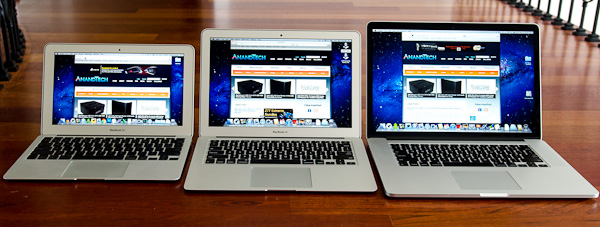
From left to right: 11-inch MacBook Air, 13-inch MacBook Air, MacBook Pro with Retina Display
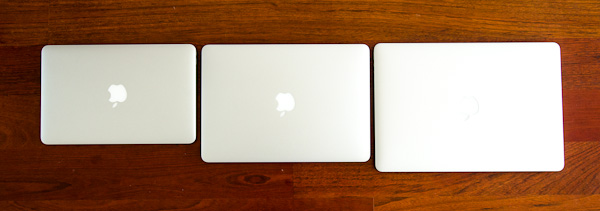
From left to right: 11-inch MacBook Air, 13-inch MacBook Air, MacBook Pro with Retina Display


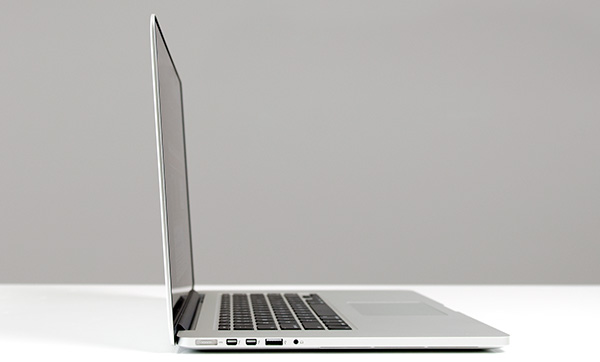
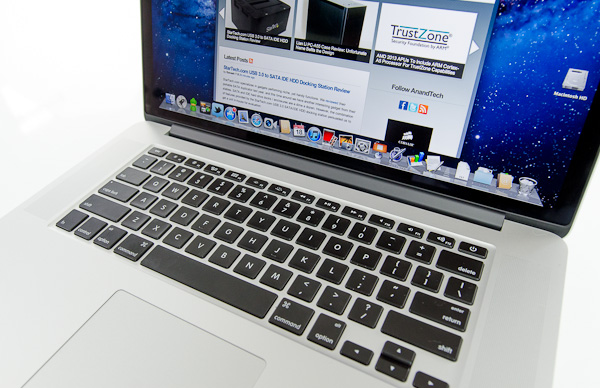
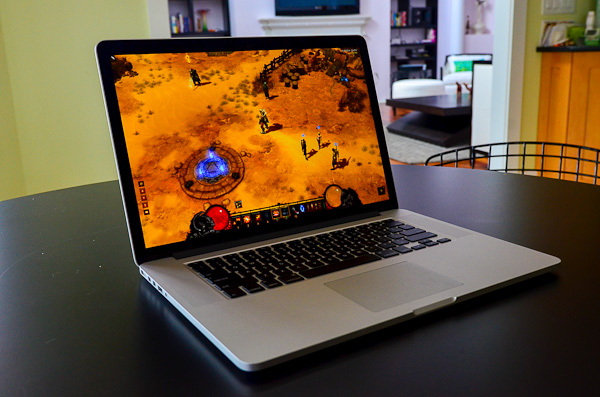
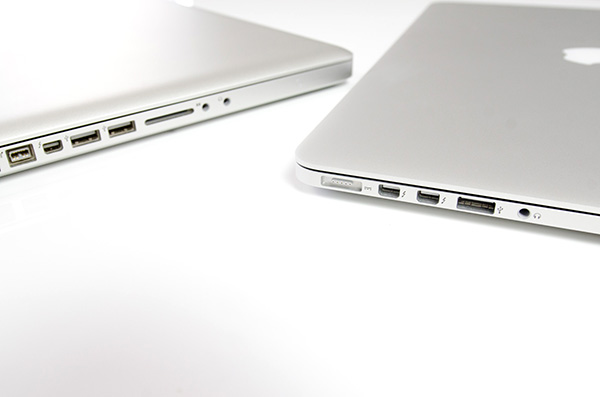
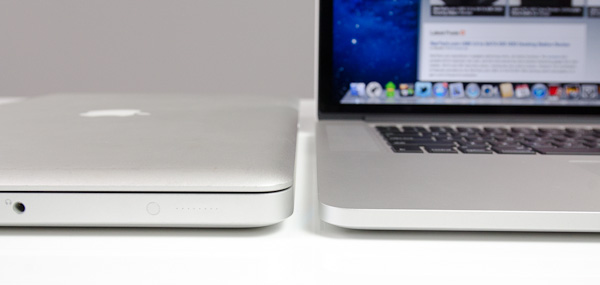








471 Comments
View All Comments
crazysurfanz - Saturday, June 23, 2012 - link
Just a pity they're USB2 ports - hopefully they'll bring out a new version with USB3.cioxx - Sunday, June 24, 2012 - link
Not everyone, perhaps even the majority of users, need ethernet on the MBPs. If Apple were to include a free adapter it would be wasteful and ultimately subsidize the few users who do need it. $30 is not a lot of money for a machine that costs over $2k.Think of that adapter as a price cut for the majority, not the other way around. Apple is still going to maintain their margin no matter what.
It's good to see them eliminate waste and make it optional. I remember getting all kinds of things with my PowerBook G4s which ended up in the landfill. Stuff like brick extensions and VGA, DVI adapters.
frabber - Saturday, June 23, 2012 - link
What if the display resolution would be set at 2880x1800 and all apps would be using scalable vector graphics in the future. Would that at least avoid any downscaling and hence improve performance? (no more choppy scrolling for example?)DeciusStrabo - Saturday, June 23, 2012 - link
Sure it would. But it would make a very hard switch for a couple of years until all Apps are using the new model. Although not worse than the model Apple now uses, where everything not made for Retina looks actually worse, not better too.solipsism - Saturday, June 23, 2012 - link
Apple has been working on RI for a long time. I think it was back in first Tiger betas that they first stated that RI would show up in the OS. It silently vanished after that. They then had a secret option that could enable RI but it was incomplete and has remained incomplete ever since.I'm guessing that it's just too resource intensive to use vectors over bitmaps for an entire OS that the user experience becomes greatly diminished. Then you have bitmaps you simply can't get away from so that becomes another obstacle.
I like how MS created the Windows Presentation Foundation that was a viable intermediate option for uses but it's not RI and it never really evolved. It did allow for object scaling in a better way than OS X but what Apple is doing now with double resolution displays trounces MS's stagnant WPF.
ananduser - Saturday, June 23, 2012 - link
RI exists in concept. Implementation however is utopic. When we are whining here about it, we're actually referring to the real life, flawed variant. Windows object scaling was always better than the OSX variant. The current unit reviewed here achieves a better result but not with standard scaling, instead with fixed presets and by obfuscating res access. The result is good but it is not resolution independent, it's in fact entirely dependent on a subset of presets which are specially tuned(with pre-rendering and such).Now I ask you, will the world devs write apps in two flavors, one to match Apple's quirky retina pre-rendering routines and one that matches W8's different approach ? Out-of-bound patches will be applied to current 3rd party osx apps just to match Apple's current implementation ?
Ryan Smith - Saturday, June 23, 2012 - link
Devs shouldn't need to do anything special for Mac OS X besides making sure their applications are HiDPI capable, which means having suitably detailed artwork and that custom widgets/text are the right physical size at 200ish DPI. In practice this means designing once on a HiDPI display, and tools take over on downresing for older displays (I'd have to check the dev documentation to see if devs need to generate those assets if the OS simply downreses assets at runtime).Metro is actually going to be more complex, since MS's guidelines suggests that devs target 100%, 140%, and 180% DPI.
ananduser - Sunday, June 24, 2012 - link
I know that itunes/Safari/3dmark on Windows don't ever plan to make proper use of WIndows resources and they will always and forever suck in this aspect.Windows is supposed to work on Earth's PCs(macs included). Isn't that an admirable goal?
I wanted to whine some more about Anand's failure to find the DPI slider in Windows but I read the review's update. Victory!
andy318 - Saturday, June 23, 2012 - link
Thanks for taking the time to write such a thorough review! You've educated us about the good and bad parts of the rMBP in a very objective manner.No one else explained the details about rendering the screen at 1680, 1920 resolutions as well as you did.
felixneo - Saturday, June 23, 2012 - link
I know that in previous posts you mention that all the 2012 lineup has 6g ssd's, but apple insist's that the retina models are equipped with these, but is silent about the rest. It is certain that the optional ssd's for MacBook Pro 15' are in fact 6G?